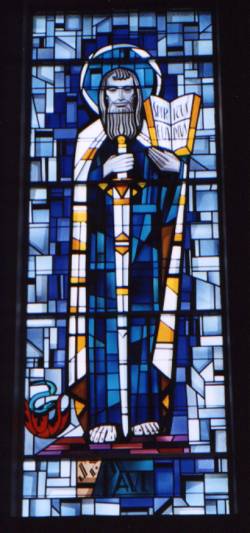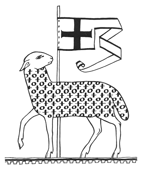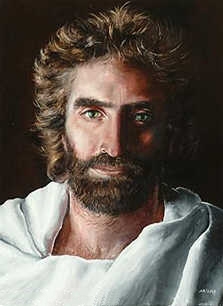
Part One: The Apostles’ Creed
2.
“
And in Jesus Christ, His Only Son, Our Lord”
 The second article of the Apostles’ Creed follows logically on the first. Once we realize that mankind lost God’s friendship at the dawn
of human history, the coming of Christ takes on a profound meaning.
The second article of the Apostles’ Creed follows logically on the first. Once we realize that mankind lost God’s friendship at the dawn
of human history, the coming of Christ takes on a profound meaning.
We believe that God became man in the person of Jesus Christ. We do not know whether the Incarnation would have taken place if man had not sinned. But we are sure that the Incarnation did take place because sin entered the world through Adam. In other words, the basic reason for the Incarnation is the need for man’s redemption. Our focus in looking at the second article of the Creed will be very exact. We will consider, in sequence, each of four terms, namely, Jesus, Christ, Son of God, and our Lord.
JesusThe New Testament origins for the name Jesus are associated with two events in the gospels, the Annunciation of Mary and the revelation to St. Joseph.At the Annunciation, the Angel Gabriel appeared to our Lady and addressed her as “full of grace.” She was disturbed by these words. So the angel reassured her. “Mary, do not be afraid,” he said. “You have won God’s favor. Listen! You are to conceive and bear a son, and you must name him Jesus” (Luke 1:30-31). Some time later, Gabriel again appeared, but this time to St. Joseph, who was understandably worried because Mary, his betrothed, had mysteriously conceived. Jewish law required that he put her away, yet he decided to do so quietly in order to spare her publicity. The angel told him: “Joseph, son of David, do not be afraid to take Mary home as your wife, because she has conceived what is in her by the Holy Spirit. She will give birth to a son and you must name Him Jesus, because he is the one who is to save his people from their sins” (Matthew 1:20-21). The name “Jesus” is the Latin form of the Greek Iesous, whose Hebrew is Yeshua, which means “Yahweh is salvation.” Already in the Book of Genesis, after our first parents had sinned, God promised to send a Redeemer. Addressing the devil, He said: “I will put enmity between you and the woman, between your seed and her seed; she shall crush your head and you shall lie in wait for her heel” (Genesis 3:15). The seed of the woman, whom we identify with Mary, was to be descended from Adam. This same promise of a Redeemer was to be repeated many times in the Old Testament. And always the stress was on Yahweh as the one who saves. When it appears that He will not save, there is no one else who can save (Psalm 18:42). Yahweh alone saves (Hosea 13:4). The frequently occurring phrases “God of my (your, his) salvation” and “rock of my (your, his) salvation” are simply variants of the same basic theme. So often is Yahweh invoked or described by titles which use the words “save” and “salvation” that these can be called His most characteristic titles in the Old Testament. This emphasis on Yahweh’s saving power dramatically attests that the Incarnation was far more clearly predicted in the Jewish prophets than the rejection of Jesus by the Jewish leaders might seem to indicate. Time and again, without ceasing, the Old Testament insists that only God can save. Logically, then, God would become man to save His people from their sins.
ChristThe name “Christ” is taken from the Greek Christos, which means “Anointed.” It corresponds exactly to the Hebrew Mashiah or Messiah.Anointing was the normal way in which kings, priests, and sometimes prophets were invested with special powers by God for the exercise of their office among the people of Israel. In what sense was Jesus anointed? He was not anointed by any mortal hand or with earthly ointment. He was anointed by the power of His heavenly Father with such fullness of the Holy Spirit as no mere created being could receive. We may, therefore, say that the humanity of Jesus was anointed with the Divinity. As a result, the human nature of Jesus was hypostatically — that is, personally — united with the Divinity. Yet all the while, the human nature of Jesus remained truly human. It was and is human like ours, in everything but sin. Even as prophets, priests, and kings were anointed with material oil, so Jesus was anointed with the spiritual oil which conferred on Him the fullness of prophetic, priestly, and royal power. Jesus was and is the great Prophet (Greek prophetes = one who teaches or speaks for another). He is the Teacher, as He called Himself, whose human lips and actions reveal to us the mind and will of God. Jesus was and is the great High Priest who sacrificed Himself on the Cross for our salvation. He continues to offer Himself in the Holy Sacrifice of the Mass. Jesus was and is the King who has authority to govern and direct not only Christian believers, but the whole human race. When during His Passion Pilate asked Him, “So you are a King then,” Jesus answered: “Yes, I am a King. I was born for this; I came into the world for this; to bear witness to the truth; and all who are on the side of truth listen to my voice” (John 18:37). Jesus was saying more than meets the eye. He is King, indeed, because He is the divine Ruler of the world in human form. But His rule is not coercive. We must voluntarily hear His commands, which means listening to His voice, if we are humbly to submit to His words.
Son of God
The key words are “His only Son,” where each word has been chiseled out of the conflict between orthodox and heterodox Christian teaching. By the middle of the fifth century, the Church was ready to formulate her belief in the unique divine sonship of Jesus of Nazareth. Already at the Annunciation, the angel had told Mary that the child she was to conceive would be called “Son of the Most High”. From the Annunciation on, learned voices were raised to explain away the literal meaning of the angel’s message to Mary. Strange names like Arius and Nestorius, Eutyches and Sabellius, Priscillian and Apollinaris are identified with heresies that in one way or another qualified Christ’s true Divinity. By the middle of the fifth century our familiar Nicene Creed was formulated, which stated in clear language what this unique sonship of Jesus Christ really means. The Nicene Creed declares: “We believe…in one Lord Jesus Christ, the only-begotten Son of God, born of the Father before all time; Light from Light, true God from true God; begotten, not created, consubstantial with the Father, through Him all things were made.” Because of the critical importance of this mystery of faith, it will be worth looking more closely at every term on the subject in the Nicene Creed. The Only Begotten Son of God. Jesus Christ had a natural human mother, Mary. But he had no natural human father. St. Joseph was not the natural father of Jesus. The natural father of Jesus is the First Person of the Holy Trinity, who is God the Father. Certainly we are all children of God, who is our Creator-Father. Certainly God is also the Father of our supernatural life, which we received at baptism. The essence of fatherhood is to share the same nature with its offspring. None of us is the natural son of God either by creation - when we were conceived in our mother’s womb - or by baptism - when we were born into the life of grace. The best we can call ourselves is “adopted children of God.” Eternal Generation of the Son of God. The First Person of the Trinity never began to generate the Second Person. The Son has always proceeded from the Father, and will continue to do so for all eternity. This is so true, that all other generations of human offspring by their earthly fathers take place only because there is in God Himself the everlasting generation of the Son from the Father. Light from Light. In the text of the Nicene Creed we profess at Mass are the expressions, “God from God, Light from Light, True God from True God”. This is to declare how totally the nature of the Son is identical with the nature of the Father from whom He proceeds. The one proceeding is equally God, equally true God, equally one as light is identical with its originating light. Begotten, Not Made. Our Faith insists that the Second Person is not made by the Father because the Son is not created out of nothing. Rather, He is begotten of the Father. Why? Because He is “one in Being with the Father.” At the Council of Nicea, the Greek word homoousios was coined to state in the clearest possible terms that the Son has the self-same (homo) Being (ousia) as the Father. Through Him All Things Were Made. Since the Son is one in Being with the Father, He is equally Creator with the Father. This is stated in the opening words of St. John’s Gospel. “Through Him,” that is, through God “all things came to be, not one thing had its being but through Him” (John 1:2-3). Thus the whole created universe depends on the Son, who is the Wisdom of the father, no less than it depends on the Father, who is Almighty Power.
Our LordIn the light of what we have discussed, there can be no doubt why Jesus Christ is our Lord:

Copyright © 2002 Inter Mirifica
Pocket Catholic Catechism |
 The
Apostles’ Creed wisely places the profession of faith in Jesus
as the Son of God before going on to declare that He was
born of the Virgin Mary. No single mystery of Christianity has been
more widely and militantly opposed than the unqualified Divinity
of Christ. We may say that everything else depends on this.
The
Apostles’ Creed wisely places the profession of faith in Jesus
as the Son of God before going on to declare that He was
born of the Virgin Mary. No single mystery of Christianity has been
more widely and militantly opposed than the unqualified Divinity
of Christ. We may say that everything else depends on this.